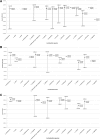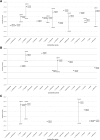The dynamics of vaginal and rectal Lactobacillus spp. flora in subsequent trimesters of pregnancy in healthy Polish women, assessed using the Sanger sequencing method
- PMID: 30157784
- PMCID: PMC6114255
- DOI: 10.1186/s12884-018-1987-7
The dynamics of vaginal and rectal Lactobacillus spp. flora in subsequent trimesters of pregnancy in healthy Polish women, assessed using the Sanger sequencing method
Abstract
Background: Lactobacilli play an important role in maintaining vaginal health and protection against bacterial infections in the genital tract. The aim of this study is to show the dynamics of changes of the vaginal and rectal Lactobacillus flora during pregnancy by using the Sanger sequencing method.
Method: The study included 31 healthy pregnant women without clinical signs of genitourinary infections. The material was taken in the three trimesters of pregnancy by vaginal and rectal swabs and grown on the MRS agar quantitatively to estimate the number of Lactobacillus spp. [CFU/ml]. Afterwards, 3 to 8 morphologically different lactobacilli colonies were taken for identification. Bacterial species identification was performed by 16 s rDNA sequence fragment analyses using the Sanger method.
Results: Among the patients tested, the most common species colonizing the vagina in the first trimester were: L. crispatus 29%, L. gasseri 19.4% and L. rhamnosus 16.1%, in the second trimester: L. crispatus 51.6%, L. gasseri 25.8%, L. rhamnosus 19.4% and L. amylovorus 16.1%, and in the third trimester the most common Lactobacillus species were: L. crispatus 25.8%, L. gasseri 25.8% and L. johnsonii 19.4%. In rectal species, the number decreased in the second and third trimesters in comparison to the first trimester (p = 0.003). An analysis of rectal dynamics showed that in the first trimester, the most common species were: L. johnsonii 19.4%, and L. plantarum 9.7%, in the second trimester: L. crispatus 9.7% and L. mucosae 6.5%, and in the third trimester: L. casei 9.7% and L. rhamnosus 9.7%. Individual dynamics of the Lactobacillus species composition showed variability, characterized by continuous, intermittent, or periodic colonization. The patients examined were mostly colonized by three Lactobacillus species in vagina (32.3%), whereas for the rectum, one Lactobacillus species during the whole pregnancy duration was common (32.3%).
Conclusion: This study showed that in the examined group of healthy, pregnant Polish women, the vaginal Lactobacillus flora, both qualitative and quantitative, was stable during the three subsequent trimesters. In contrast, the number of rectal Lactobacillus species dramatically decreased after the first trimester.
Keywords: Healthy pregnant women; Lactobacillus spp.; Vaginal and rectal colonization.
Conflict of interest statement
Ethics approval and consent to participate
The study was approved by Jagiellonian University Bioethical Committee decisions No. KBET/47/B/2009. The consent obtained from the participants was both informed and written.
Consent for publication
Not applicable.
Competing interests
The authors declare that they have competing interests.
Publisher’s Note
Springer Nature remains neutral with regard to jurisdictional claims in published maps and institutional affiliations.
Figures




Similar articles
-
Dynamics of colonization with group B streptococci in relation to normal flora in women during subsequent trimesters of pregnancy.New Microbiol. 2014 Jul;37(3):307-19. Epub 2014 Jul 1. New Microbiol. 2014. PMID: 25180845
-
Using of the 16S rDNA sequencing for identification of Lactobacillus species.Med Dosw Mikrobiol. 2016;68(1):5-11. Med Dosw Mikrobiol. 2016. PMID: 28146617
-
Vaginal Lactobacillus microbiota of healthy women in the late first trimester of pregnancy.BJOG. 2007 Nov;114(11):1402-7. doi: 10.1111/j.1471-0528.2007.01412.x. Epub 2007 Sep 17. BJOG. 2007. PMID: 17877778
-
New findings about vaginal bacterial flora.Rev Assoc Med Bras (1992). 2010 May-Jun;56(3):370-4. doi: 10.1590/s0104-42302010000300026. Rev Assoc Med Bras (1992). 2010. PMID: 20676549 Review. English, Portuguese.
-
[Vaginal microbiota: composition, protective role, associated pathologies, and therapeutic perspectives].Enferm Infecc Microbiol Clin. 2008 Mar;26(3):160-7. doi: 10.1157/13116753. Enferm Infecc Microbiol Clin. 2008. PMID: 18358215 Review. Spanish.
Cited by
-
The Prevalence, Antibiotic Resistance Pattern, and Associated Factors of Bacterial Vaginosis Among Women of the Reproductive Age Group from Felege Hiwot Referral Hospital, Ethiopia.Infect Drug Resist. 2021 Jul 13;14:2685-2696. doi: 10.2147/IDR.S305329. eCollection 2021. Infect Drug Resist. 2021. PMID: 34285521 Free PMC article.
-
Distribution of Vaginal and Gut Microbiome in Advanced Maternal Age.Front Cell Infect Microbiol. 2022 May 27;12:819802. doi: 10.3389/fcimb.2022.819802. eCollection 2022. Front Cell Infect Microbiol. 2022. PMID: 35694547 Free PMC article.
-
The sow vaginal and gut microbiota associated with longevity and reproductive performance.J Anim Sci Biotechnol. 2025 Jan 7;16(1):6. doi: 10.1186/s40104-024-01140-2. J Anim Sci Biotechnol. 2025. PMID: 39762999 Free PMC article.
-
Group B streptococcus in pregnant women and neonates in Africa: a scoping review.BMJ Public Health. 2025 Jul 23;3(2):e002263. doi: 10.1136/bmjph-2024-002263. eCollection 2025. BMJ Public Health. 2025. PMID: 40734961 Free PMC article.
-
The interplay between the gut microbiota and metabolism during the third trimester of pregnancy.Front Microbiol. 2022 Dec 7;13:1059227. doi: 10.3389/fmicb.2022.1059227. eCollection 2022. Front Microbiol. 2022. PMID: 36569048 Free PMC article.
References
MeSH terms
Grants and funding
LinkOut - more resources
Full Text Sources
Other Literature Sources
Medical
Miscellaneous

